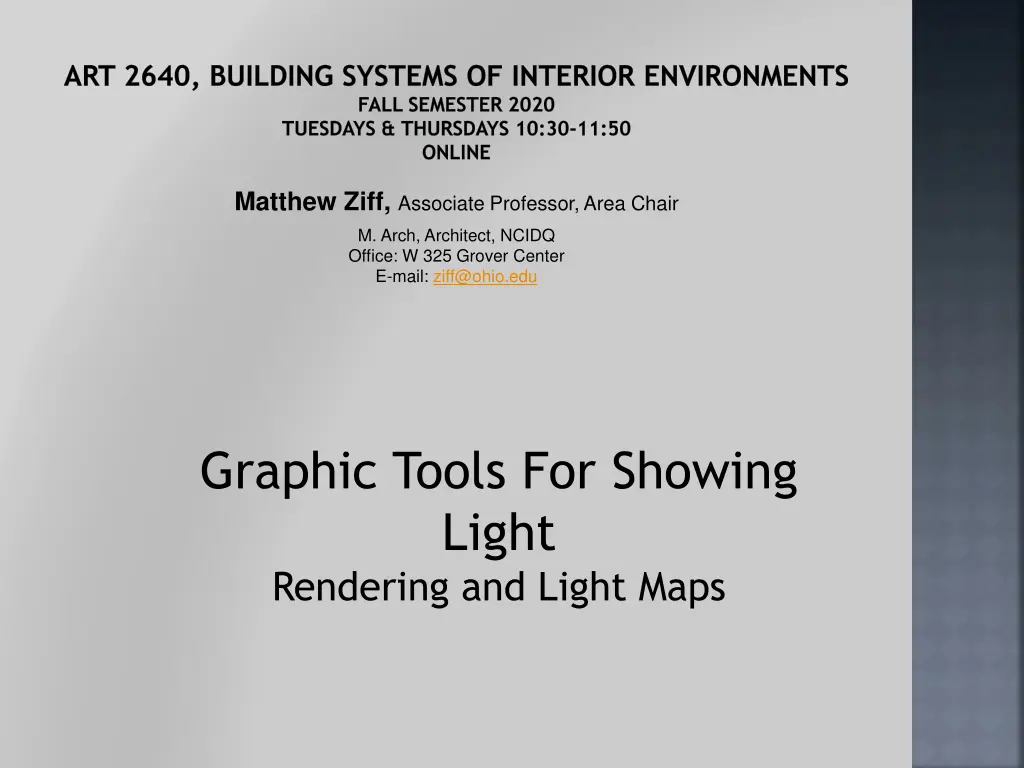
Light Mapping Techniques for Interior Design Success
Explore the art of light mapping in interior design by creating a visual representation of desired lighting effects on surfaces and objects. Learn to use color, texture, and intensity to influence mood and enhance the interaction of light with the environment. Discover the key elements and measurements of lighting units to effectively plan and execute lighting designs for interior spaces.
Download Presentation

Please find below an Image/Link to download the presentation.
The content on the website is provided AS IS for your information and personal use only. It may not be sold, licensed, or shared on other websites without obtaining consent from the author. If you encounter any issues during the download, it is possible that the publisher has removed the file from their server.
You are allowed to download the files provided on this website for personal or commercial use, subject to the condition that they are used lawfully. All files are the property of their respective owners.
The content on the website is provided AS IS for your information and personal use only. It may not be sold, licensed, or shared on other websites without obtaining consent from the author.
E N D
Presentation Transcript
ART 2640, BUILDING SYSTEMS OF INTERIOR ENVIRONMENTS FALL SEMESTER 2020 TUESDAYS & THURSDAYS 10:30-11:50 ONLINE Matthew Ziff, Associate Professor, Area Chair M. Arch, Architect, NCIDQ Office: W 325 Grover Center E-mail: ziff@ohio.edu Graphic Tools For Showing Light Rendering and Light Maps
LIGHT MAPPING: SHOWING LIGHT Draw the light that you want to create for the space. Use yellow, yellow orange, orange pencils Indicate where you wish to see light on surfaces, objects, etc. Remember; light is only seen on surfaces, not in the air.
THIS IS A LIGHT MAP
THE LIGHT MAPPED PLAN THE KEYS TO SUCCESS IN CREATING A LIGHT MAP Think only in terms of light you want to create. Not: Practicality Ability to construct Luminaire location Luminaire Think about the quality of light and where it goes Focus on surfaces and objects and how they receive and reflect light
THE LIGHT MAPPED PLAN Adding to the impact of a Light Map Vary rendering techniques to represent different sources Create a legend that explains what you are showing Describing Light Annotate details that can not be clearly understood through the drawing alone Color, texture, and intensity of the light How light effects mood How the light interacts with surfaces When in doubt, add a description Use the 5 layers of light when developing a light map. Light Mapping Choreography Develop symbols
LIGHTING UNITS AND MEASUREMENTS
ITS ALL ABOUT THE LUMEN Foot-Candle light produced onto an object a foot away from a candle Lumen the basis of all lighting study Onto or striking a surface illuminance /1 fc = 1 lumen / 1 sq ft. Off or leaving a surface exitance / no unit of measurement Exitance = illuminance multiplied(x) reflectance of surface If reflectance is 50%, existance is half the illuminance Leaving a surface in a specific direction with a specific density Candelas per square meter (CD/sq.M) steradian of spherical area area made of a portion of a sphere
UNDERSTANDING ILLUMINANCE LEVELS
ILLUMINANCE LEVEL INTUITION Foot Candles = FC Full Moon Light = 0.1 FC Exterior Parking Lot = 1.0 FC Dim, Romantic restaurant = 5.0 FC Comfortable Living Room = 10 15 FC Residential den / study = 20 35 FC Classroom / Open Office = 50 70 FC Laboratory / Exam Room = 100 FC
ADDING ILLUMINANCE VALUES TO A LIGHT MAP Annotate Light Map Indicate foot candle requirement Based on tasks 5 35 foot candles = ambience 35 55 fc = common in office areas, classrooms, etc.
LIGHTING FOR VISUAL INTEREST Accent and feature lighting 2 times rule Object should be two times brighter than adjacent surface 2 to 5 times is comfortable More than 5 times creates glare Example = wall surface has 10 fc Art would have 20 to 50 fc
IES ILLUMINANCE LEVEL CRITERIA Illuminating Engineering Society of North America (IESNA) Scientific body that studies light and its effects on human visual performance www.iesna.org Published book
IES ILLUMINANCE LEVEL CRITERIA Lighting Design Concerns Checklist Desired contrast / distinct accents Desired sparkle / visible sources Accurate color rendering Color Appearance of environment Mood and emotional atmosphere Modeling of objects and faces Visual Task performance System control and dimming Daylighting integration / control
IES ILLUMINANCE LEVEL CRITERIA Lighting Design Concerns Checklist Glare Reflections / Specular Materials Sensitivity to flicker / strobe effect Sensitivity to glare Energy Conservation / efficiency Maintenance concerns Heat concerns Noise concerns Light level evenness (reducing shadows)
